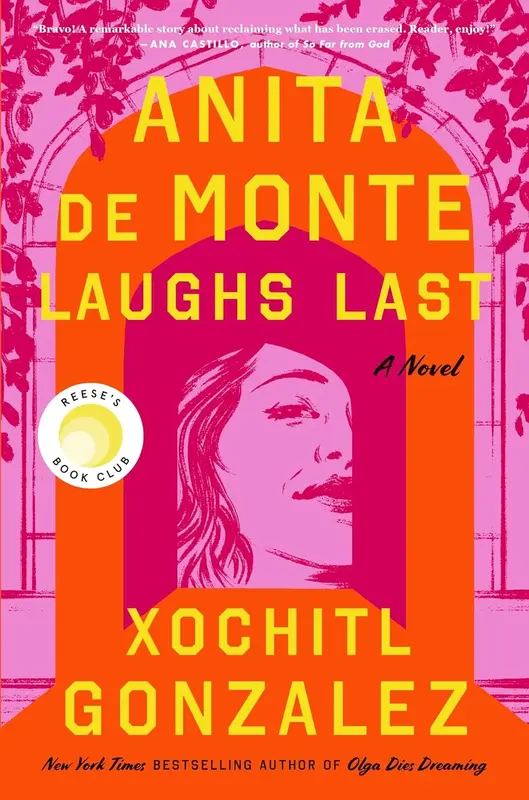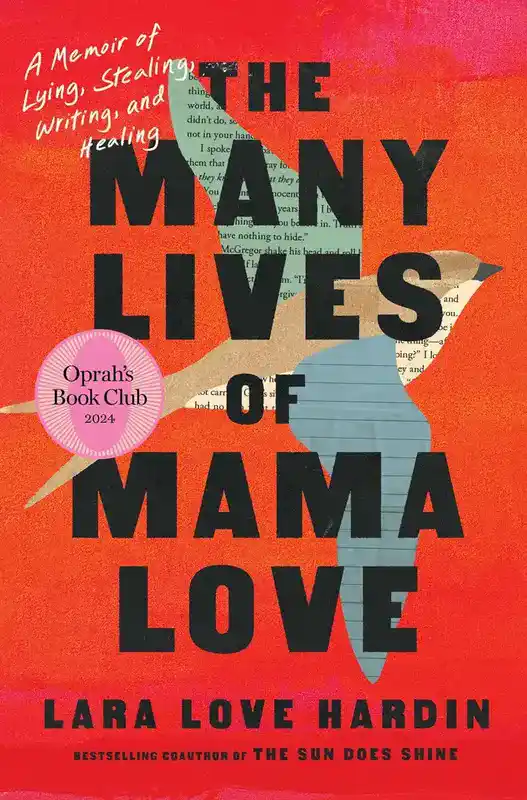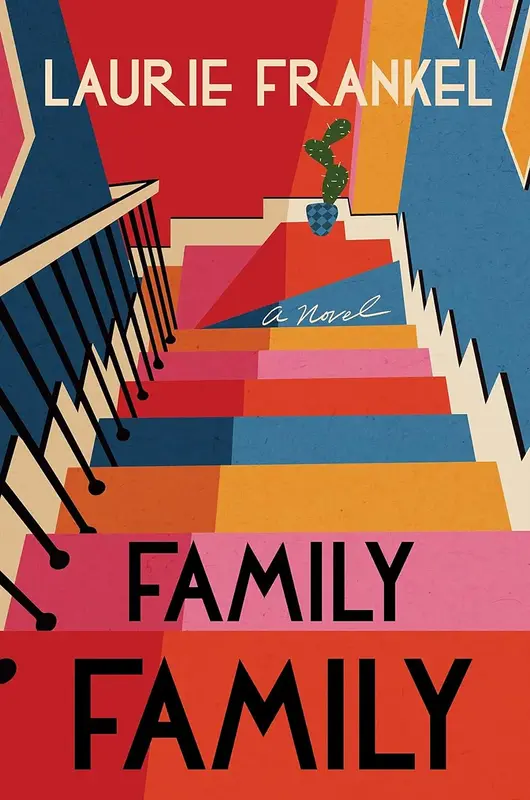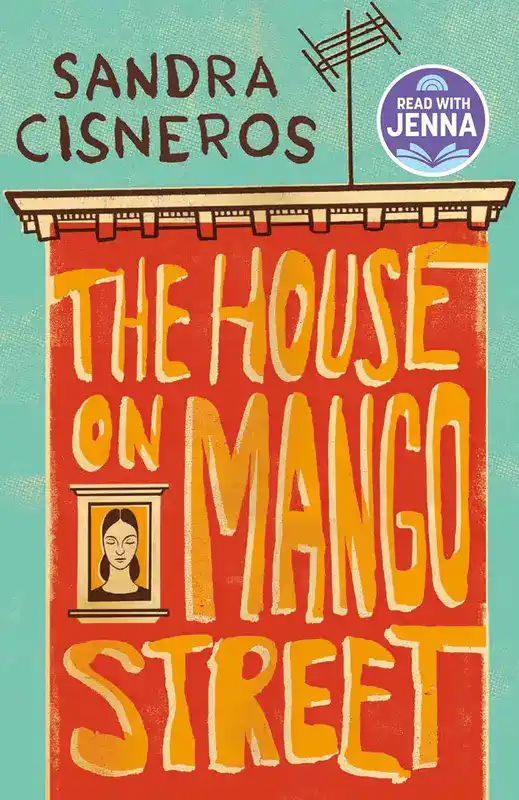This post may contain affiliate links. Read more here.
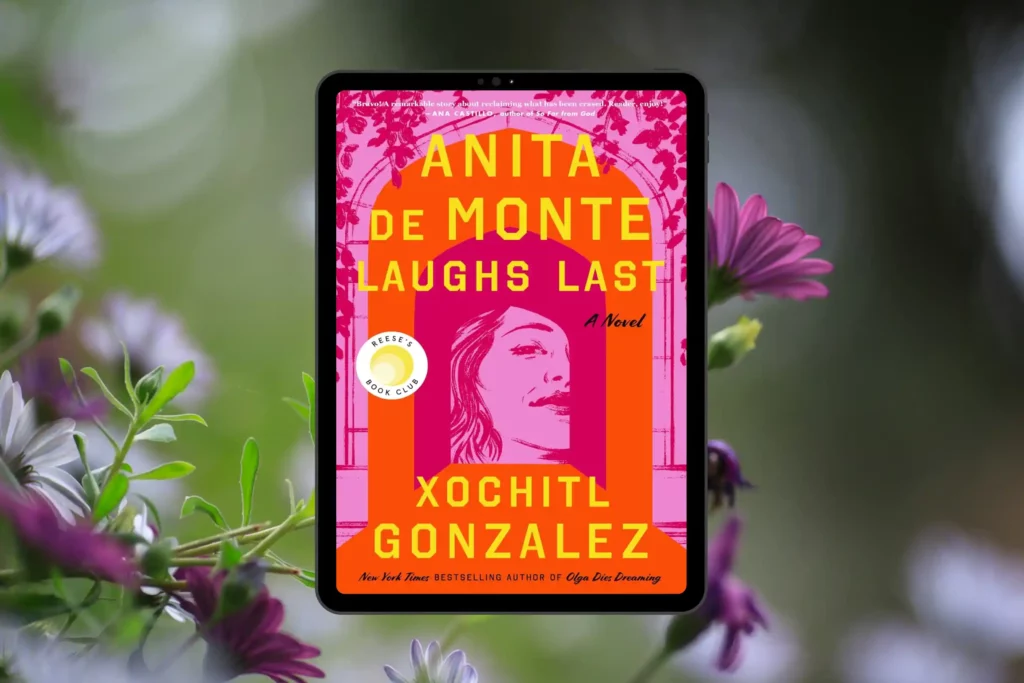
Book club questions for Anita de Monte Laughs Last by Xochitl Gonzalez explore the themes of identity, privilege, and the intricacies of artistry and memory.
This is an eye opening, beautiful story.
Gonzalez does a great job describing New York City and the 1980s art scene, along with campus life and the racial and class differences of that era. Even though the book deals with important issues, it’s not too serious. In fact, there are many funny moments! The story is well-balanced, the setting feels real, and the characters are memorable. Plus, you’ll have a new perspective on bats after reading it!
I didn’t know this story was inspired by a real artist, Ana Mendieta. Now I’m curious to learn more about her. I appreciate how this book sheds light on forgotten events and people, which feels empowering. It shows that although women have made some progress in being seen, we still need to do more to recognize minorities and their valuable contributions to our communities and the world.
Let me know your thoughts about the novel! Feel free to comment below.
Anita de Monte Laughs Last by Xochitl Gonzalez
In this blog post you will find the discussion questions for Anita de Monte Laughs Last by Xochitl Gonzalez.
Book club questions may also prompt discussions on the dynamics of relationships, both romantic and societal, the impact of societal expectations on individual aspirations, and they may examine the parallels between past and present, highlighting the importance of remembering and honoring marginalized voices in history and art.
Have a wonderful book club discussion! ✨
About the Author | Book Club Questions | Additional Recommendations
About the Story
Anita de Monte Laughs Last is set in 1985 New York City and follows the mysterious death of rising art star Anita de Monte. Fast forward to 1998, where Raquel, a third-year art history student, discovers Anita’s forgotten story while navigating the elitist world of Ivy League academia.
Raquel, feeling like an outsider as a student of color, finds herself entangled in a romance with a well-connected art student. As she delves into Anita’s past, parallels emerge between their lives, prompting Raquel to question her own relationships and societal dynamics.
Told from the perspectives of both women and weaving between past and present, this novel challenges notions of remembrance and the marginalized in elite circles, and is a compelling read for anyone intrigued by history, art, and the complexities of human connection.
Release date: March 5, 2024
Genre: Hispanic American Literature & Fiction
Hardcover: 352 pages
Publisher: Flatiron Books
About the Author
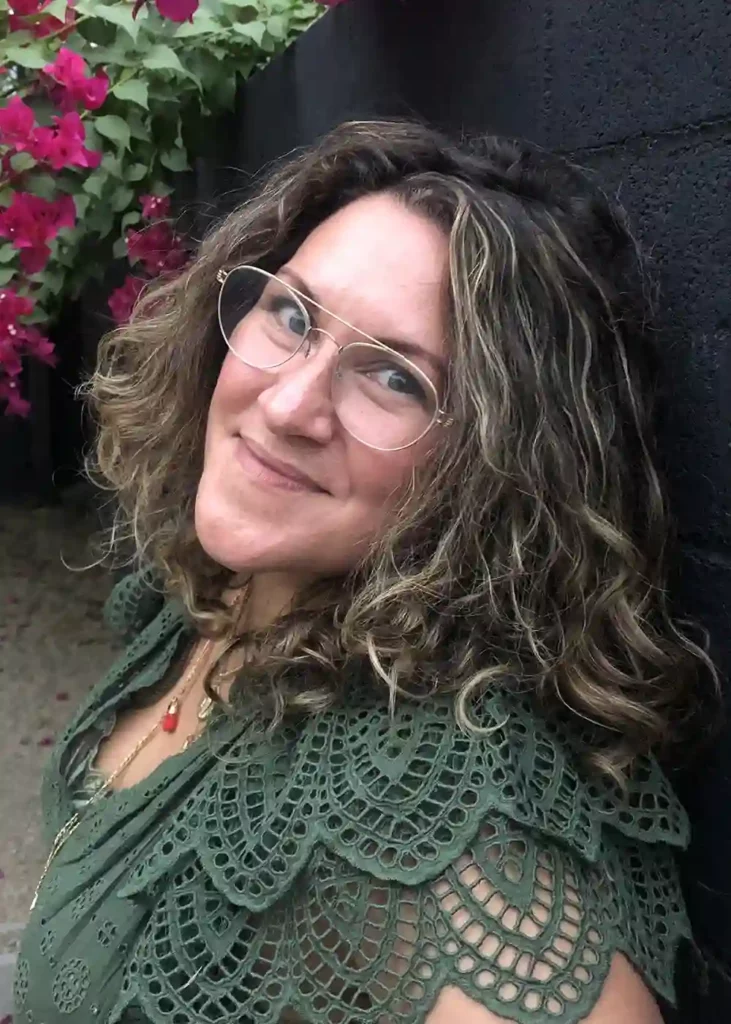
Xochitl Gonzalez, a native New Yorker from Brooklyn, wears many hats – she’s a writer, cultural critic, and producer. Her debut novel, Olga Dies Dreaming, soared to the New York Times bestseller list, earning praise from top publications like The New York Times, TIME, Kirkus, Washington Post, and NPR. For this book, she scooped up awards including the Brooklyn Public Library Book Prize in Fiction and the New York City Book Awards.
She’s not just a fiction wizard – Xochitl graduated from the renowned Iowa Writers’ Workshop with an M.F.A. in 2021 and has penned compelling non-fiction pieces for Elle Decor, Allure, Vogue, Real Simple, and The Cut. While writing for The Atlantic, she made waves as a Pulitzer Prize finalist in Commentary.
Before diving into writing, Xochitl hustled in various roles like entrepreneur, fundraiser, consultant, wedding planner, tarot reader, and more. She’s deeply connected to her community, serving on the boards of the Lower East Side Girls Club and the Brooklyn Public Library, plus as a trustee of her alma mater, Brown University.
Brooklyn is her heart and soul, where she resides with her loyal pup, Hectah Lavoe. And her latest literary gem, Anita de Monte Laughs Last, hit the shelves in March 2024, promising another captivating tale.
Book Club Questions for Anita de Monte Laughs Last
Disclaimer: the following discussion questions contain spoilers, so proceed with caution if you haven’t finished the book yet.
- In the opening chapter, Anita de Monte’s artwork is debated by two white men, including her future husband Jack Martin. How does this scene establish the power dynamics within the art world and foreshadow Anita’s struggles throughout the novel?
- Reflecting on Jack Martin’s character, how does his behavior towards Anita evolve over the course of their relationship? Can you identify key moments where his actions contribute to Anita’s sense of marginalization and frustration?
- Anita’s death is shrouded in mystery, with conflicting accounts and suspicions surrounding her husband Jack Martin. How does the novel build tension around Anita’s demise, and what impact does this unresolved mystery have on the narrative?
- What were your initial impressions of Anita and Raquel as characters? Did your perception of them change throughout the story?
- Analyze the significance of the dual timelines in the novel, particularly in juxtaposing Anita’s experiences in the 1980s art scene with Raquel’s journey in the late 1990s. How does this narrative structure enhance the reader’s understanding of both characters’ struggles and aspirations?
- Discuss the theme of identity and belonging in the book, particularly in relation to Anita and Raquel’s experiences as women of color.
- How do you personally perceive the power dynamics and sense of belonging in the social gatherings attended by Anita and Raquel? How did these scenes resonate with your own experiences or observations?
- Reflect on your engagement with the characters’ perspectives, considering the alternating first-person and third-person narrative styles. How did this storytelling approach affect your emotional connection to Anita, Raquel, and Jack?
- Reflecting on the portrayal of relationships in the novel, compare and contrast Anita’s marriage with Jack Martin and Raquel’s relationship with Nick Fitzsimmons. How do these romantic dynamics shape the characters’ personal growth and trajectories?
- Thinking about Raquel’s deep connection to hip hop and art history, how do these influences mirror or diverge from your own passions or interests? How did they shape your understanding of Raquel’s character?
- The novel explores the power dynamics within relationships, both romantic and professional. How did these dynamics influence the characters’ decisions and actions?
- What role does art play in the story, and how does it contribute to the overall themes of empowerment and recognition?
- Reflect on the portrayal of societal issues such as racism, sexism, and classism in the book. How effectively were these issues addressed?
- Consider the significance of memory and remembrance in the narrative. How does the novel challenge traditional notions of history and who gets to be remembered?
- Discuss the role of humor and magical realism in the story. How did these elements impact your reading experience?
- Consider the impact of the non-linear storytelling on your reading experience. How did the glimpses into Anita’s past enhance your understanding of her journey and the themes of the novel?
- Drawing from your own experiences or observations, how did the romantic relationships of Anita and Raquel resonate with you? In what ways did they reflect common challenges or dynamics in relationships?
- Raquel Toro’s journey at Brown University intersects with her discovery of Anita de Monte’s art and legacy. Can you discuss the pivotal moments where Raquel’s research into Anita’s life influences her own identity and ambitions?
- The portrayal of the “Art History Girls” clique provides insight into the racial and economic dynamics within academia. How do these characters contribute to Raquel’s sense of belonging, and how do they reflect broader issues of privilege and exclusion?
- Discuss the racial and economic dynamics depicted in Raquel’s college experience, particularly in her interactions with the privileged “Art History Girls” and her relationship with Nick Fitzsimmons. How do these dynamics shape Raquel’s perception of herself and her aspirations?
- Reflecting on the portrayal of Anita’s artistic career, how does the novel critique the art world’s treatment of women and artists of color? How does Anita’s story shed light on broader issues of representation and recognition in the arts?
- Reflect on the portrayal of the Art History Girls and their influence on Raquel’s sense of identity and belonging. How did their interactions with Raquel evoke any memories or reflections on your own friendships or social circles?
- Reflect on the significance of Anita’s transformation into a bat and its implications for her storyline. How did this supernatural element affect your interpretation of her character and her journey?
- Which moments of reclamation in Anita’s artistic journey resonated with you on a personal level? How did they inspire you to reflect on reclaiming your own narratives or achievements?
- How did the various perspectives on Anita’s death shape your understanding of her legacy and the challenges faced by women artists? Did any of these perspectives remind you of similar situations in your own life or in history?
- Think about the role of family in shaping Raquel and Nick’s decisions and actions. How did their familial backgrounds prompt you to reflect on your own family dynamics and their influence on your life choices?
- Consider the guidance provided to Raquel by John Temple and Belinda Kim. How did their mentorship styles resonate with your own experiences of receiving advice or guidance from mentors or role models?
- Choose a theme from the novel that deeply resonated with you, such as feminism or artistry. How did this theme personally affect you or prompt you to reconsider your own beliefs or perspectives?
- Analyze the relationships between the main characters, including Anita, Raquel, and Jack. How do these relationships evolve throughout the novel?
- What were your overall thoughts on the book’s ending? Did it leave you satisfied, or were there unresolved questions or themes that lingered for you?
- Reflecting on the parallels between Anita’s life and the real-life experiences of Ana Mendieta, how does the novel navigate the blurred lines between fiction and reality? In what ways does the novel pay homage to Mendieta’s legacy while also offering a fictionalized interpretation of her story?
Additional Recommendations
Hope you enjoyed the book club discussion questions and reading guide for Anita de Monte Laughs Last by Xochitl Gonzalez. Here are some more of my book club recommendations from this author, with themes related to this book, along with their synopses:
The Many Lives of Mama Love by Lara Love Hardin
New York Times bestselling author Lara Love Hardin recounts her slide from soccer mom to opioid addict to jailhouse shot caller and her unlikely comeback as a highly successful ghostwriter in this harrowing, hilarious, no-holds-barred memoir.
No one expects the police to knock on the door of the million-dollar two-story home of the perfect cul-de-sac housewife. But soccer mom Lara Love Hardin has been hiding a shady secret: she is funding her heroin addiction by stealing her neighbors’ credit cards.
Lara is convicted of thirty-two felonies and becomes inmate S32179. She finds that jail is a class system with a power structure that is somewhere between an adolescent sleepover party and Lord of the Flies. Furniture is made from tampon boxes, and Snickers bars are currency. But Lara quickly learns the rules and brings love and healing to her fellow inmates as she climbs the social ladder and acquires the nickname “Mama Love,” showing that jailhouse politics aren’t that different from the PTA meetings she used to attend.
When she’s released, she reinvents herself as a ghostwriter. Now, she’s legally co-opting other people’s identities and getting to meet Oprah, meditate with the Dalai Lama, and have dinner with Archbishop Desmond Tutu. But the shadow of her past follows her. Shame is a poison worse than heroin—there is no way to detox. Lara must learn how to forgive herself and others, navigate life as a felon on probation, and prove to herself that she is more good than bad, among other essential lessons.
The Many Lives of Mama Love is a heartbreaking and tender journey from shame to redemption, despite a system that makes it almost impossible for us to move beyond the worst thing we have ever done.
Family Family by Laurie Frankel
“Not all stories of adoption are stories of pain and regret. Not even most of them. Why don’t we ever get that movie?”
India Allwood grew up wanting to be an actor. Armed with a stack of index cards (for research/line memorization/make-shift confetti), she goes from awkward sixteen-year-old to Broadway ingenue to TV superhero.
Her new movie is a prestige picture about adoption, but its spin is the same old tired story of tragedy. India is an adoptive mom in real life though. She wants everyone to know there’s more to her family than pain and regret. So she does something you should never do ― she tells a journalist the truth: it’s a bad movie.
Soon she’s at the center of a media storm, battling accusations from the press and the paparazzi, from protesters on the right and advocates on the left. Her twin ten-year-olds know they need help – and who better to call than family? But that’s where it gets really messy because India’s not just an adoptive mother…
The one thing she knows for sure is what makes a family isn’t blood. And it isn’t love. No matter how they’re formed, the truth about family is this: it’s complicated.
The House on Mango Street by Sandra Cisneros
A coming-of-age classic about a young girl growing up in Chicago • Acclaimed by critics, beloved by readers of all ages, taught in schools and universities alike, and translated around the world—from the winner of the 2019 PEN/Nabokov Award for Achievement in International Literature.
The House on Mango Street is one of the most cherished novels of the last fifty years. Readers from all walks of life have fallen for the voice of Esperanza Cordero, growing up in Chicago and inventing for herself who and what she will become. “In English my name means hope,” she says. “In Spanish it means too many letters. It means sadness, it means waiting.”
Told in a series of vignettes—sometimes heartbreaking, sometimes joyous—Cisneros’s masterpiece is a classic story of childhood and self-discovery and one of the greatest neighborhood novels of all time. Like Sinclair Lewis’s Main Street or Toni Morrison’s Sula, it makes a world through people and their voices, and it does so in language that is poetic and direct. This gorgeous coming-of-age novel is a celebration of the power of telling one’s story and of being proud of where you’re from.
Happy reading! ❤️
